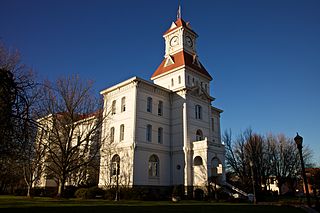
Corvallis is a city in and the county seat of Benton County in central western Oregon, United States. It is the principal city of the Corvallis, Oregon Metropolitan Statistical Area, which encompasses all of Benton County. As of the 2023 Census Population Estimates, the population was 61,087, making it the 9th most populous city in Oregon. This does include the nearly 25,000 Oregon State University students attending classes in Corvallis, over 5,250 of which live in one of 16 residence Halls on the main campus. Corvallis is the location of Oregon State University 420-acre main campus, Samaritan Health Services, a top 10 largest non-profit employer in the state, a 84-acre Good Samaritan Regional Medical Center campus, and a 2.2 million square foot, 197-acre Hewlett Packard research and development campus that invented the Laser jet printer and the Computer mouse. Corvallis is a part of the Silicon Forest Corvallis is the westernmost city in the contiguous 48 states with a population larger than 50,000.

Salem is the capital city of the U.S. state of Oregon, and the county seat of Marion County. It is located in the center of the Willamette Valley alongside the Willamette River, which runs north through the city. The river forms the boundary between Marion and Polk counties, and the city neighborhood of West Salem is in Polk County. Salem was founded in 1842, became the capital of the Oregon Territory in 1851, and was incorporated in 1857.

Baker City is a city in and the county seat of Baker County, Oregon, United States. It was named after Edward Dickinson Baker, the only U.S. Senator ever killed in military combat. The population was 10,099 at the time of the 2020 census.
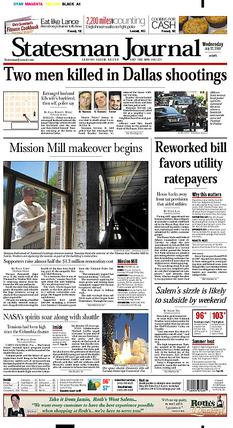
The Statesman Journal is the major daily newspaper published in Salem, Oregon, United States. Founded in 1851 as the Oregon Statesman, it later merged with the Capital Journal to form the current newspaper, the second-oldest in Oregon. The Statesman Journal is distributed in Salem, Keizer, and portions of the mid-Willamette Valley. The average weekday circulation was 27,859, with Sunday's readership listed at 36,323, in 2012.. It is owned, along with the neighboring Stayton Mail and Silverton Appeal Tribune, by the national Gannett Company.

Cherriots, officially the Salem Area Mass Transit District, is a public transit operator based in Salem, Oregon, United States. The agency, whose name refers to the city's nickname, provides bus and paratransit service in Salem and neighboring Keizer. It was founded in 1979 as the Salem Area Mass Transit District, replacing municipal and private systems, and renamed itself to Salem-Keizer Transit in 2003. In 2023, the system had a ridership of 3,133,700, or about 18,900 per weekday as of the first quarter of 2024.

The Corvallis Gazette-Times is a daily newspaper for Corvallis, Oregon, United States. The newspaper, along with its sister publication, the Albany Democrat-Herald of neighboring Albany, Oregon, is owned by Lee Enterprises of Davenport, Iowa.
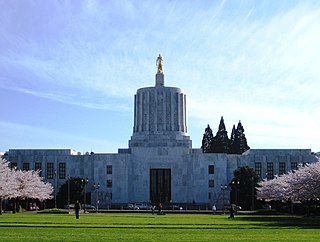
The Oregon State Capitol is the building housing the state legislature and the offices of the governor, secretary of state, and treasurer of the U.S. state of Oregon. It is located in the state capital, Salem. Constructed from 1936 to 1938 and expanded in 1977, the current building is the third to house the Oregon state government in Salem. The first two capitols in Salem were destroyed by fire, one in 1855 and the other in 1935.

The Grand Theatre is part of a complex of historic buildings in Salem, Oregon, United States that was originally owned by the fraternal organization Independent Order of Odd Fellows, and listed on the National Register of Historic Places (NRHP) as the Chemeketa Lodge No. 1, Odd Fellows Buildings. The theater building is also known as the I.O.O.F. Temple.

Salem Hospital is a non-profit, regional medical center located in Salem, Oregon, United States. Founded in 1896, the hospital has 454 beds. A Level II trauma center, the community hospital is the largest private employer in Salem and the only hospital in the city. Salem Hospital is one of five Magnet designated hospitals in Oregon.
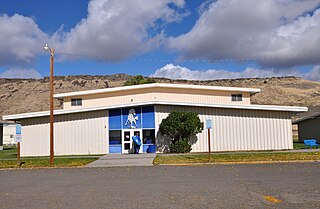
Crane Union High School is a public high school in Crane, Oregon, United States. It is a boarding school that serves students from a large geographic area.
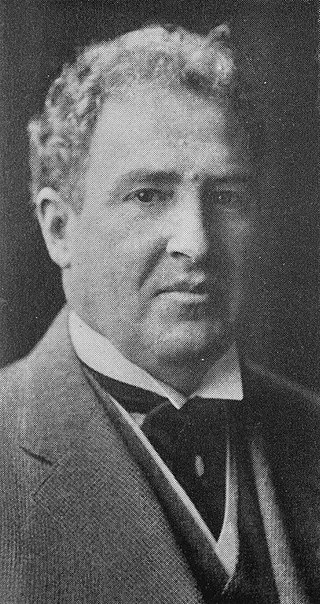
John Virginius Bennes was an American architect who designed numerous buildings throughout the state of Oregon, particularly in Baker City and Portland. In Baker City he did an extensive redesign of the Geiser Grand Hotel, designed several homes, and a now-demolished Elks building. He moved to Portland in 1907 and continued practicing there until 1942.
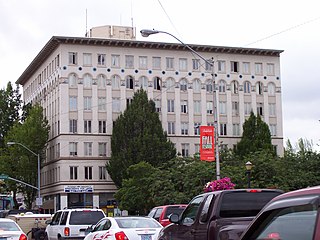
The Hotel Benton, or Benton Hotel, is a historic former hotel in Corvallis, Oregon, United States. Constructed from 1924 to 1925, the building represents a distinctive example of the Italian Renaissance style by Portland architects Houghtaling and Dougan. It is one of several Oregon buildings the firm designed in the revival styles popular in the 1920s and 1930s.
The 1947 Oregon State Beavers football team was an American football team that represented Oregon State College in the Pacific Coast Conference (PCC) during the 1947 college football season. Led by thirteenth-year head coach Lon Stiner, the team compiled a 5–5 record, and outscored their opponents 171 to 136.
The 1899 Oregon Agricultural Aggies football team represented Oregon Agricultural College as an independent during the 1899 college football season. In their first and only season under head coach Hiland Orlando Stickney, the Aggies compiled a 3–2 record and outscored their opponents by a combined total of 76 to 60. The Aggies lost to Oregon, 38–0. Fred Walters was the team captain.

The Pomona Hotel fire occurred on July 7, 1975 when Roy Jennings Beard, a 57-year-old transient in northwest Portland, Oregon, United States, set the building ablaze in an act of arson on the second floor. A total of eight people died during the initial fire, and an additional four succumbed to injuries in the subsequent weeks and months, making it the deadliest fire in the city's history. A total of 26 others were injured in the fire.

Kessler Richard Cannon was an American radio broadcaster and state legislator from Oregon. He was a Republican who served two two-year terms in the Oregon House of Representatives. Outside the legislature, Cannon was a broadcaster and executive for radio station KBND in Bend. He also served as Governor Tom McCall's assistant for natural resources before becoming director of the Oregon Department of Environmental Quality.

KVDO-TV was a television station broadcasting on channel 3 in Salem, Oregon, United States, that operated between 1970 and 1983. Originally intended as a local independent station serving the Willamette Valley, financial considerations resulted in a contested sale to Liberty Television, owner of KEZI in Eugene, Oregon, in 1972. However, for media concentration reasons, the Federal Communications Commission ordered KVDO-TV sold within three years. As a result, the Oregon Educational and Public Broadcasting Service (OEPBS) acquired KVDO-TV in 1976, resulting in a station that often—and controversially—duplicated OEPBS's transmitters at Portland and Corvallis.

DoubleTree by Hilton Hotel Portland is a hotel in Portland, Oregon's Lloyd District, in the United States. The hotel opened as the Sheraton-Portland Hotel in 1959, and in 1980 became the Red Lion Inn/Lloyd Center.






















